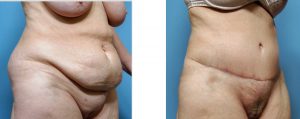
The fundamental concept of a tummy tuck is that tissue is surgically removed or excised and this always includes skin. Many less invasive abdominal contouring techniques have been called a ‘tummy tuck’ but if they do not remove skin it is not a tummy tuck and the expected results should not be expected to be remotely the same. Thus, liposuction is not a tummy tuck and no matter how much (or so little) skin is tightened does not make it a tummy tuck. Liposuction will always produce less of a result as it can not remove and tighten loose skin.
To help one understand the range of available tummy tuck options, a classification of levels of increasing extent of the procedure can be very helpful. This is not a formal method of describing tummy tucks ascribed to by plastic surgeons in general, but one that has allowed me to help my patients choose and understand what type of tummy tuck is best for them.
LEVEL I (mini-tummy tuck) When the horizontally-oriented segment of skin and fat that is removed is taken below the belly button, it is a mini-tummy tuck. The horizontal length of the tissue removed may be very small or larger but the length of the resultant scar will lie within the two hip points. (anterior superior iliac spine) There will be no scar on the outer belly button. The belly button may be left in place or separated from underneath at the abdominal wall and brought down into a new lower position if this will help smooth out any loose skin that exists above it. Muscle repair can still be done for the whole vertical length of the rectus muscles, just below the belly button to the pubis or not at all based on the patient’s needs.
LEVEL II (mini-tummy tuck with liposuction) Since the effects of any tummy tuck stop at the end of the incision, liposuction can be done for any bulging at the waistline into the flanks or even throughout the entire upper abdomen above where the mini-tummy tuck is done.

LEVEL IV (full tummy tuck with flank liposuction) Since the shaping effects of any tummy tuck never go beyond the end of the incisions, many patients need liposuction of their flanks (hip rolls, love handles) to create a more complete waistline contouring effect. But liposuction is not usually done or advised throughout the entire upper abdomen due its potential adverse healing effects on the tummy tuck incision.
LEVEL V (extended full tummy tuck, abdominal pannoculectomy) When the amount of loose skin extends around the sides and into the back area, liposuction can not effectively treat it. The excision of loose skin and fat can be extended beyond that of the traditional full tummy tuck to get rid of the folds of skin. This results in a longer scar that will extend into the sides and back area. The need for this type of tummy is in significant weight loss patients, (e.g., bariatric surgery) and those patients with overhanging aprons (pannus) of tissue.

LEVEL VII (circumferential tummy tuck, belt lipectomy, lower body lift) In extreme weight loss patients, when the trunk tissues look like wax melting off a candle, the excess and loose tissues need to be removed circumferentially. Wrapping around the waistline 360 degrees, a combined full tummy tuck and upper buttock lift is achieved in one operation.
LEVEL VIII (reverse tummy tuck, upper tummy tuck) When the loose abdominal tissues is only above the belly button (usually after a fully lower tummy tuck), the concept of a tummy tuck can be reversed and done from above. Skin and fat is removed from the upper abdomen, lifted and closed along the lower breast folds. (inframammary creases) The only exposed portion of the scar is in the small area between the breasts in the midline sternal area.
Dr. Barry Eppley
Indianapolis, Indiana


